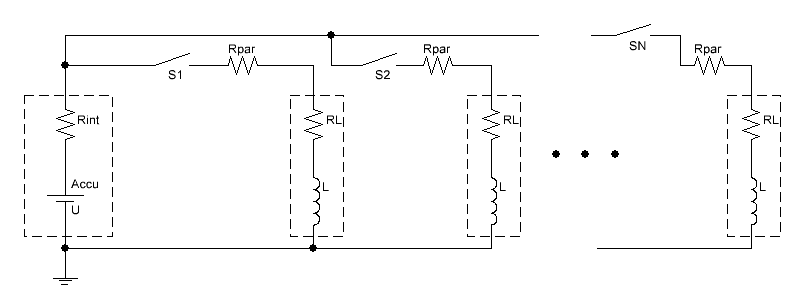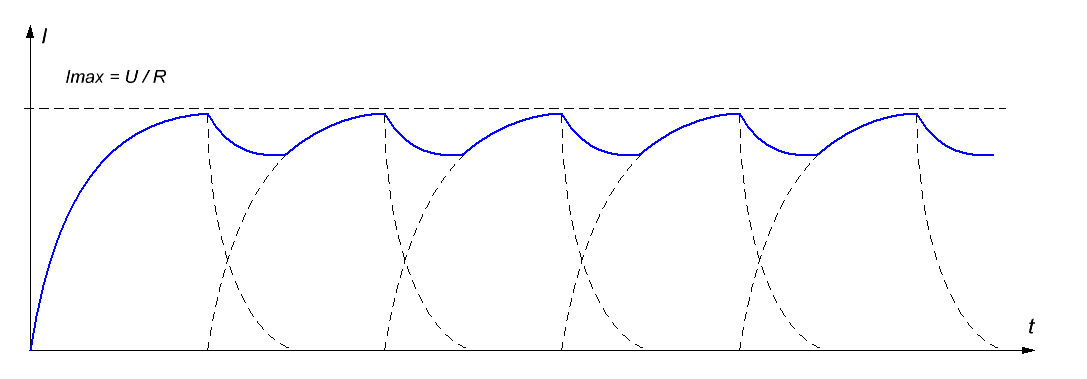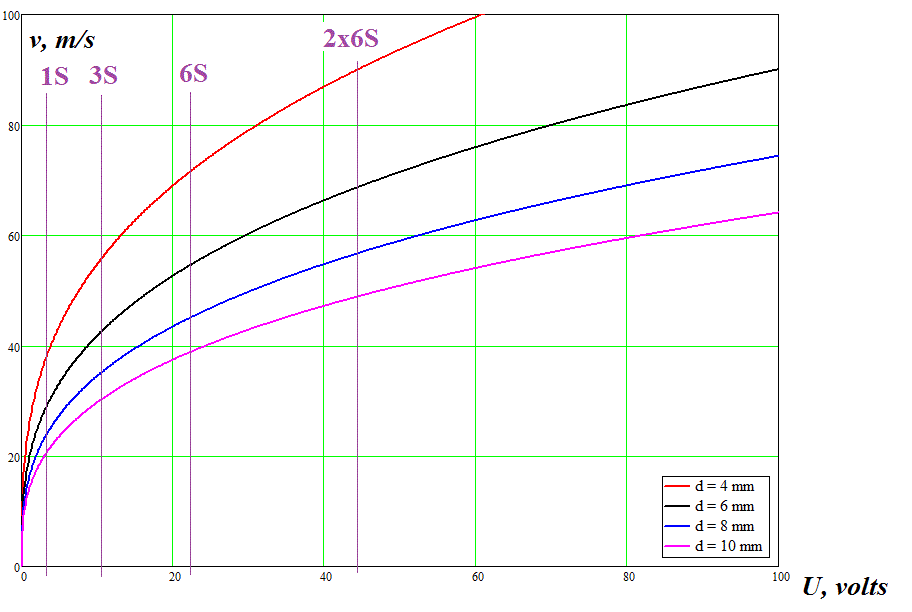
Maximum speed in accumulator-driven multistage coilgun
_Eugen_, Tue Jul 30 2019, 01:28PMAn equation for output projectile velocity in an accumulator-driven reluctance launcher is derived. Influence of an internal accu resistance is investigated. Comparison with experimental results is given.
All details are here as usual, below are only main resuls and conclusions.
Re: Maximum speed in accumulator-driven multistage coilgun
_Eugen_, Tue Jul 30 2019, 01:43PM


The scheme and current waveforms of the multistage accumulator-driven reluctance launcher.
_Eugen_, Tue Jul 30 2019, 01:43PM


The scheme and current waveforms of the multistage accumulator-driven reluctance launcher.
Re: Maximum speed in accumulator-driven multistage coilgun
_Eugen_, Tue Jul 30 2019, 01:49PM
Significant roles are played by an internal accumulator resistance Rint and parasitic circuit resistance Rpar.
The parasitic chain resistance is treated rather simply – it is determined by on –resistance of the switch, and interconnections. On-resistance of the modern low-voltage MOSFETs is limited not by their chips (which are very low-ohmic), but their leads and makes no more than 5 milliohms (mOhms) as a rule. The same can be suggested for the resistance of the connections (provided they are made of copper buses of enough cross-sections and well-soldered everywhere). In total we get about 10 mOhms ( i. e. one-hundred part of Ohm) for Rpar. Perhaps it is too “overoptimistic†assessment and Rpar in a real construction (especially with long bore demanding prolonged buses) may be higher, but it is OK for our rough calculation.
Rint is assessed by introduction of some coefficient r which can be called “relative internal resistance†of the accu. Its dimension is Ohm·(mA·h)/V, and a resistance of an arbitrary accumulator will be deduced from r by the following equation:
Rint = r ·U / C
where U,C – battery voltage and capacity, accordingly.
r ≈ 4 Ohm·(mA·h)/V for modern LiPos.
_Eugen_, Tue Jul 30 2019, 01:49PM
Significant roles are played by an internal accumulator resistance Rint and parasitic circuit resistance Rpar.
The parasitic chain resistance is treated rather simply – it is determined by on –resistance of the switch, and interconnections. On-resistance of the modern low-voltage MOSFETs is limited not by their chips (which are very low-ohmic), but their leads and makes no more than 5 milliohms (mOhms) as a rule. The same can be suggested for the resistance of the connections (provided they are made of copper buses of enough cross-sections and well-soldered everywhere). In total we get about 10 mOhms ( i. e. one-hundred part of Ohm) for Rpar. Perhaps it is too “overoptimistic†assessment and Rpar in a real construction (especially with long bore demanding prolonged buses) may be higher, but it is OK for our rough calculation.
Rint is assessed by introduction of some coefficient r which can be called “relative internal resistance†of the accu. Its dimension is Ohm·(mA·h)/V, and a resistance of an arbitrary accumulator will be deduced from r by the following equation:
Rint = r ·U / C
where U,C – battery voltage and capacity, accordingly.
r ≈ 4 Ohm·(mA·h)/V for modern LiPos.
Re: Maximum speed in accumulator-driven multistage coilgun
_Eugen_, Tue Jul 30 2019, 01:56PM
Basic equation for the output speed of the accelerator which was derived:

Here η is efficiency of the coilgun, l - its length (sum of all accelerating windings), m - mass of the projectile.
Accounting for the parasitic resistance essentially leads to decrease of the speed (one term adds to the denominator).
_Eugen_, Tue Jul 30 2019, 01:56PM
Basic equation for the output speed of the accelerator which was derived:

Here η is efficiency of the coilgun, l - its length (sum of all accelerating windings), m - mass of the projectile.
Accounting for the parasitic resistance essentially leads to decrease of the speed (one term adds to the denominator).
Re: Maximum speed in accumulator-driven multistage coilgun
_Eugen_, Tue Jul 30 2019, 02:00PM
Figure below shows the results obtained from the equation above for v when C = 5200 mA·h (which is close to maximum for the elements in stock) and variable voltage. Data for different coilgun calibers (d) from 4 to 10 mm are demonstrated. The length of the projectile of iron considered 4d (and so its mass m was determined). The values of 1S (single bank) to 2x6S (two sequentially connected six-bank accumulators which gives 44,4 V on output) are marked on the voltage scale. Acceleration path is 50 cm. The efficiency was considered equal to the caliber in mm (like I did in previuos calculations), which is close to truth for multistage accelerators.

_Eugen_, Tue Jul 30 2019, 02:00PM
Figure below shows the results obtained from the equation above for v when C = 5200 mA·h (which is close to maximum for the elements in stock) and variable voltage. Data for different coilgun calibers (d) from 4 to 10 mm are demonstrated. The length of the projectile of iron considered 4d (and so its mass m was determined). The values of 1S (single bank) to 2x6S (two sequentially connected six-bank accumulators which gives 44,4 V on output) are marked on the voltage scale. Acceleration path is 50 cm. The efficiency was considered equal to the caliber in mm (like I did in previuos calculations), which is close to truth for multistage accelerators.

Re: Maximum speed in accumulator-driven multistage coilgun
_Eugen_, Tue Jul 30 2019, 02:09PM
It is interesting to compare the results to the parameters of the really built ADGs. The figure below gives such comparison for two models; *CG-42 by J.Murray and *EMG-01 form ArcFlashLabs (in fact, that is the same coilgun with the capacitor added between the accu and the coils for the second model). The parameters of the accelerators taken for the calculation (according to the author’s information) are in the table.

To correct the data from simplified eq. for v, formula including the parasitic chain resistance Rpar = 10 mOhms was used (which is indicated by the dashed line for CG-42). Experimental results are depicted by big rhombic symbols.

The graphs show that for the case described by the derived equation (i.e .pure RL-circuit without any caps but with a parasitic resistance) the calculative result coincides with the experiment very well. Contrary, an addition of the capacitive element to the circuit increases the output velocity drastically, and the formulae obtained above become inapplicable.
_Eugen_, Tue Jul 30 2019, 02:09PM
It is interesting to compare the results to the parameters of the really built ADGs. The figure below gives such comparison for two models; *CG-42 by J.Murray and *EMG-01 form ArcFlashLabs (in fact, that is the same coilgun with the capacitor added between the accu and the coils for the second model). The parameters of the accelerators taken for the calculation (according to the author’s information) are in the table.

To correct the data from simplified eq. for v, formula including the parasitic chain resistance Rpar = 10 mOhms was used (which is indicated by the dashed line for CG-42). Experimental results are depicted by big rhombic symbols.

The graphs show that for the case described by the derived equation (i.e .pure RL-circuit without any caps but with a parasitic resistance) the calculative result coincides with the experiment very well. Contrary, an addition of the capacitive element to the circuit increases the output velocity drastically, and the formulae obtained above become inapplicable.
Re: Maximum speed in accumulator-driven multistage coilgun
_Eugen_, Tue Jul 30 2019, 02:16PM
What can we say looking at the results?
First, the equations derived show a weak (as a cubic root) dependence of v on the initial parameters of the system. I.e., to double the speed, we should increase, for example, voltage in 8 times. This means that improvability of the portable accumulator-driven coilgun is in quite narrow borders.
Secondly, the graphs demonstrates that v increases with shrinking of the gauge (which corresponds to my *previous assessments of the parameters of accelerators build on other principles). However, the speed of more than 100 m/s for even 4 mm caliber (the least of examined here) is achieved only with 60 V and more battery (which is equivalent to 3 and more sequentially connected 6S accus) – this says about high cost of such a hypothetical construction. Moreover, we must take into account that the number of stages must be extended while the caliber (and hence their length) diminishes to keep a constant acceleration path (4 mm gauge implies more than 30 stages at the path of 50 cm). As each of them is equipped with high-current switch and some minimal control electronics, the constructor of ADG with a competitive parameters must be ready to more expenses than for traditional coilguns (which *have already overcome 100 m\s speed limit without any extraordinary engineering tricks).
Thirdly, the parasitic resistance has a substantial influence on the parameters of ADG at voltages low than 20 V. So, for the analyzed-above case of 3200 mA·h capacity the speed lowers doubly for the single-bank accu, and to about 10 % for 6S – type (which corresponds to η ≈ 20 % reducing efficiency) when considering Rpar. This says that the lowest voltage limit of the accumulators for ADG lays somewhere about 20 V and corresponds to 6S-accus.
Finally, the parameters of EMG-01 coilgun show that a capacitor added between power supply and accelerating coils increases the efficiency dramatically by deleting such factor as internal resistance of the accumulator. RL-circuit of ADG turns here to a “traditional†RLC-type with only difference in cap charging directly from the accu (not from a voltage booster, I examined this type of the coilguns *here). This fact reveals that conventional capacitor-driven coilguns are still more effective due to lower internal resistance of the capacitors (also called ESR) in comparison to Rint of the LiPo accumulators.
_Eugen_, Tue Jul 30 2019, 02:16PM
Discussion and conclusion.
What can we say looking at the results?
First, the equations derived show a weak (as a cubic root) dependence of v on the initial parameters of the system. I.e., to double the speed, we should increase, for example, voltage in 8 times. This means that improvability of the portable accumulator-driven coilgun is in quite narrow borders.
Secondly, the graphs demonstrates that v increases with shrinking of the gauge (which corresponds to my *previous assessments of the parameters of accelerators build on other principles). However, the speed of more than 100 m/s for even 4 mm caliber (the least of examined here) is achieved only with 60 V and more battery (which is equivalent to 3 and more sequentially connected 6S accus) – this says about high cost of such a hypothetical construction. Moreover, we must take into account that the number of stages must be extended while the caliber (and hence their length) diminishes to keep a constant acceleration path (4 mm gauge implies more than 30 stages at the path of 50 cm). As each of them is equipped with high-current switch and some minimal control electronics, the constructor of ADG with a competitive parameters must be ready to more expenses than for traditional coilguns (which *have already overcome 100 m\s speed limit without any extraordinary engineering tricks).
Thirdly, the parasitic resistance has a substantial influence on the parameters of ADG at voltages low than 20 V. So, for the analyzed-above case of 3200 mA·h capacity the speed lowers doubly for the single-bank accu, and to about 10 % for 6S – type (which corresponds to η ≈ 20 % reducing efficiency) when considering Rpar. This says that the lowest voltage limit of the accumulators for ADG lays somewhere about 20 V and corresponds to 6S-accus.
Finally, the parameters of EMG-01 coilgun show that a capacitor added between power supply and accelerating coils increases the efficiency dramatically by deleting such factor as internal resistance of the accumulator. RL-circuit of ADG turns here to a “traditional†RLC-type with only difference in cap charging directly from the accu (not from a voltage booster, I examined this type of the coilguns *here). This fact reveals that conventional capacitor-driven coilguns are still more effective due to lower internal resistance of the capacitors (also called ESR) in comparison to Rint of the LiPo accumulators.
Re: Maximum speed in accumulator-driven multistage coilgun
_Eugen_, Tue Jul 30 2019, 02:23PM
As I cannot edit my first post in the topic (something wrong with forum driver), here is a link to a full version of the article on my site:
*Assessment of maximum speed reached in accumulator-driven coilgun
_Eugen_, Tue Jul 30 2019, 02:23PM
As I cannot edit my first post in the topic (something wrong with forum driver), here is a link to a full version of the article on my site:
*Assessment of maximum speed reached in accumulator-driven coilgun
Print this page